The best headless ecommerce platforms are rapidly grabbing the attention of business owners looking to stand out from the crowd with unique customer shopping experiences.
As the commerce world continues to evolve, consumers are looking for ever-more flexible and unique interactions online.
Top Headless Ecommerce Platforms
What is a Headless Ecommerce Platform?
Headless ecommerce platforms stand as one of the powerful tools business leaders can potentially use to delight and convert their customers. These unique tools give organizations endless freedom to create fully bespoke shopping experiences across multiple channels, without compromise.
Though they’re more expensive and time-consuming than your typical ecommerce tool, the best headless platforms may be well-worth the investment for larger, growing companies. Here’s your guide to some of the top solutions on the market.
Now we’ve discussed why you might consider using a headless ecommerce platform for your store, it’s time to start looking at the tools that will help you to reach your goals.
As headless ecommerce continues to grow, there are a number of great platform providers out there to explore. Here are some of the top picks for 2023.
What are the Best Headless Ecommerce Platforms?
1. Shopify Plus
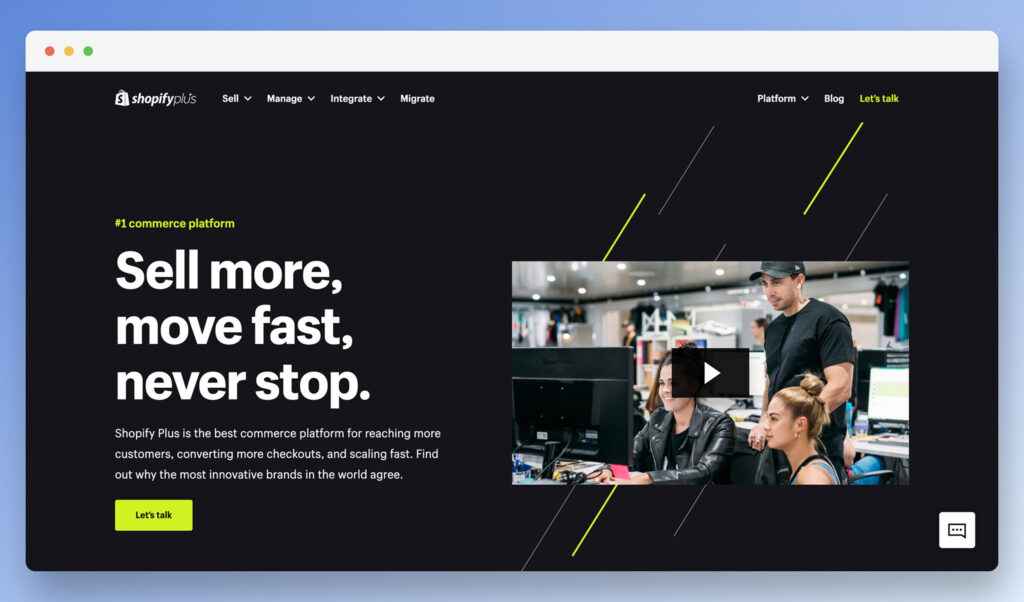
Shopify Plus is one of the better-known enterprise solutions for ecommerce store building in the modern landscape. The leading SaaS platform supports millions of active merchants around the world, with access to complete customization. You can use Shopify Plus to build a traditional online store with endless scalability, or build your own headless environment.
With Shopify Plus, it’s easy to transform any device or digital screen into a sales channel, with comprehensive functionality and complete creative control.
Teams can build storefronts with the tools they already know, and boost development with built-in Shopify tools. There’s also convenient access to a range of omnichannel sales options.
Shopify Plus simplifies the journey into headless ecommerce for growing companies, with fully built Hydrogen demo stores you can globally deploy in a single click. There’s also access to dedicated technical support, and a performance-optimized framework for speed.
You can design fast and engaging storefronts for video games, mobile, web, and beyond with the GraphQL storefront API, and attach your own technology stack into the system. Shopify integrates with everything from leading ERP tools to CRM solutions, CMS services, and PIM software. There’s even a partner network where companies can find support from new developers.
The user-friendly ecommerce website builder and headless environment makes it quick and simple to enhance user experience in real-time, to suit any business needs. You can even access order management, WordPress CMS support, and Amazon connections in the same place.
Pricing
Pricing for Shopify Plus can be a little difficult to understand at first. Costs usually start at around $2,000 per month, but you’ll need a custom quote from the team tailored to your Shopify store and sales volume. The service definitely isn’t cheap, but it does offer a lot of functionality you wouldn’t get from most ecommerce stores.
Pros 👍
- Exceptional high-speed performance across all channels
- Automated business workflows for rapid scalability
- Access to GraphQL storefront APIs to turn any screen into a digital storefront
- Easy-to-use backend for managing all of your sales channels
- Intuitive editor and direct access to code for front-end stores
- Brilliant support and partners to help with building
- Seamless integration with a variety of existing business tools
Cons 👎
- Limitations on some backend configuration options
- Limited control over certain checkout options
2. BigCommerce Enterprise
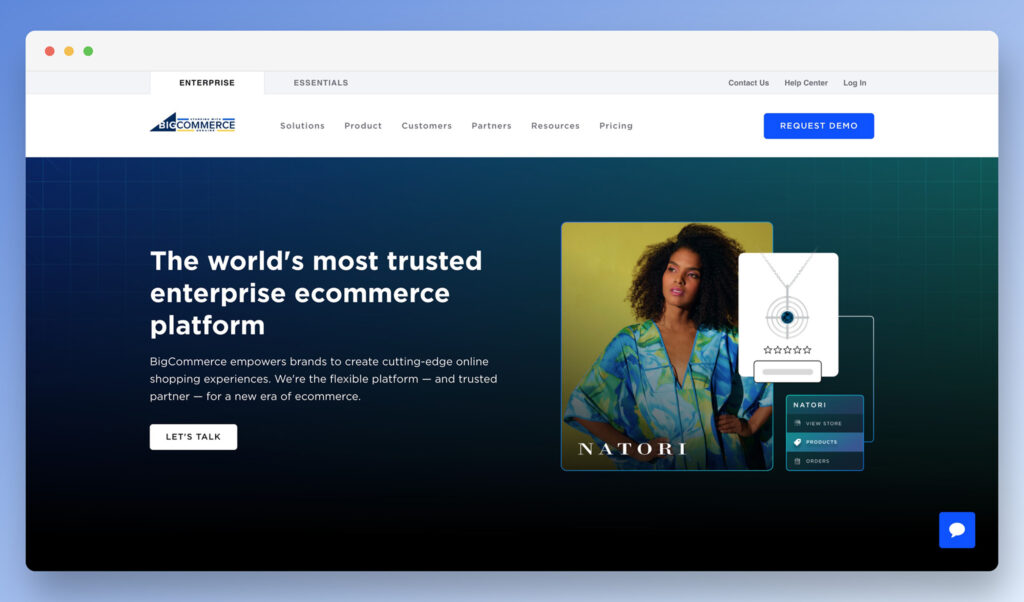
BigCommerce is another market-leading ecommerce solution with its own dedicated headless environment. Within the Enterprise pricing package, companies can access all the tools they need for unparalleled and unique customer experiences. There are also multi-storefront solutions available for both headless and Stencil storefronts via BigCommerce.
The BigCommerce ecosystem comes with access to a variety of front-end frameworks, including Next.JS commerce, Gatsby.JS for progressive web apps, and Nuxt.JS for Vue developers. BigCommerce also has its own range of content management systems available, as well as digital experience platforms, so there’s no limit to what you can do.
The back-end environment aims to make it simple to enhance your headless ecommerce environment with minimal time and effort. You can choose the CMS and technology that works best for you, and customize however you like with a range of built-in APIs.
BigCommerce even promises growing businesses unlimited scale, with the option to handle up to 600 SKUs per product. You can expect an industry-leading 99.99% average uptime from the company.
Plus, for beginners, BigCommerce has a range of knowledge base articles and how-to guides available for step-by-step instruction. The solution gives both developers and business owners endless freedom without asking them to start building their new environments again from scratch.
Pricing
BigCommerce doesn’t provide companies with a lot of direct insights into what they can expect to pay for their headless ecommerce environment. You’ll need to reach out directly to the customer service team to get a dedicated quote.
Pros 👍
- Fantastic API architecture for building custom solutions
- Create and manage multi-storefront environments in one dashboard
- Access blazing-fast performance and phenomenal uptime results
- Powerful PWA functionality, and multiple integration options
- Handles up to 600 SKUs per product for phenomenal growth
- Great customer service and guidance
Cons 👎
- Development costs can be quite expensive
- Requires some technical knowledge to get started
3. Elastic Path
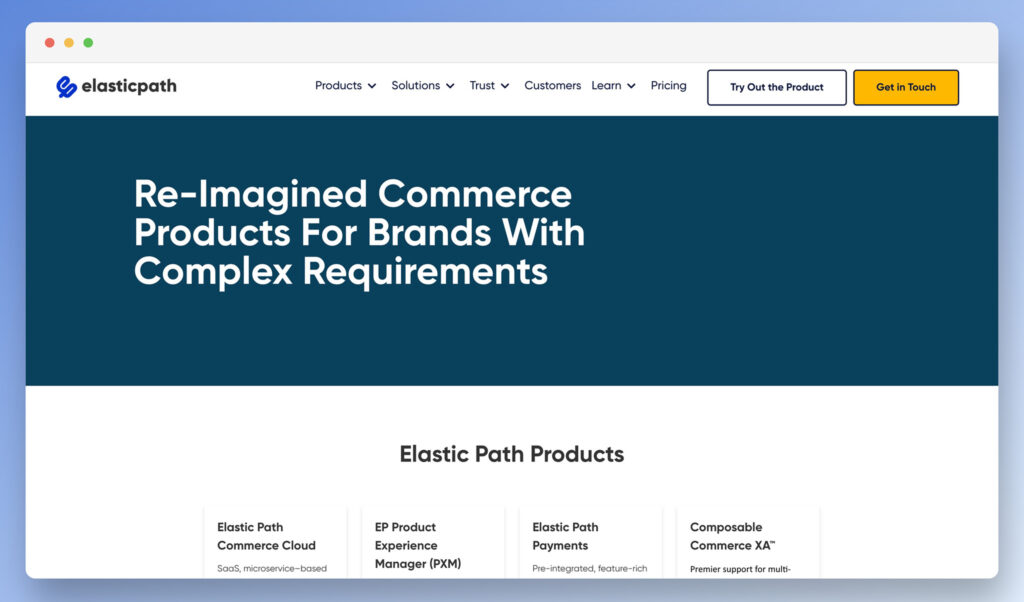
Elastic Path is an open-source and endlessly scalable solution for commerce. The comprehensive environment is specially designed for enterprise-sized businesses experiencing rapid growth. The ultra-composable environment supports multi-country, multi-business model, and multi-brand development strategies, for every organization.
You can create powerful product and catalog management experiences, without having to re-invent the wheel. There’s support for functionality across virtually every endpoint and touchpoint you can imagine. In fact, Elastic Path aims to eliminate some of the complexity involved in going headless with a ready-to-launch solution similar to a traditional ecommerce platform.
There’s a built-in experience manager, with plenty of features for customization. Plus, like Shopify, Elastic Path makes it easy to access additional help when you need it. You can partner with a trusted ally and ecommerce expert for help with multi-vendor support, and integrations. This means you don’t necessarily need to rely on a comprehensive developer team.
The front-end technology included within the platform ranges from PWA development options to AR experiences, Alexa skill references, and Facebook chatbot functionality. There are also seamless integrations available for all of the key systems you already use in the ERP, POS, and CRM worlds.
Pricing
Once again, there’s no pre-set pricing structure for Elastic Path available on the website. You’ll need to connect with the company to get a quote created specifically for your transaction volume, and desired implementation strategy.
Pros 👍
- Specially optimized for omnichannel experiences
- Endless front-end technology already included
- Strong ability to customize with endless options
- Seamless integrations with various front-end systems
- Flexible cloud agnostic deployment solutions
- Powerful partners and customer service
Cons 👎
- Can be time-consuming for beginners
- Limited documentation available for beginners
4. Adobe Commerce
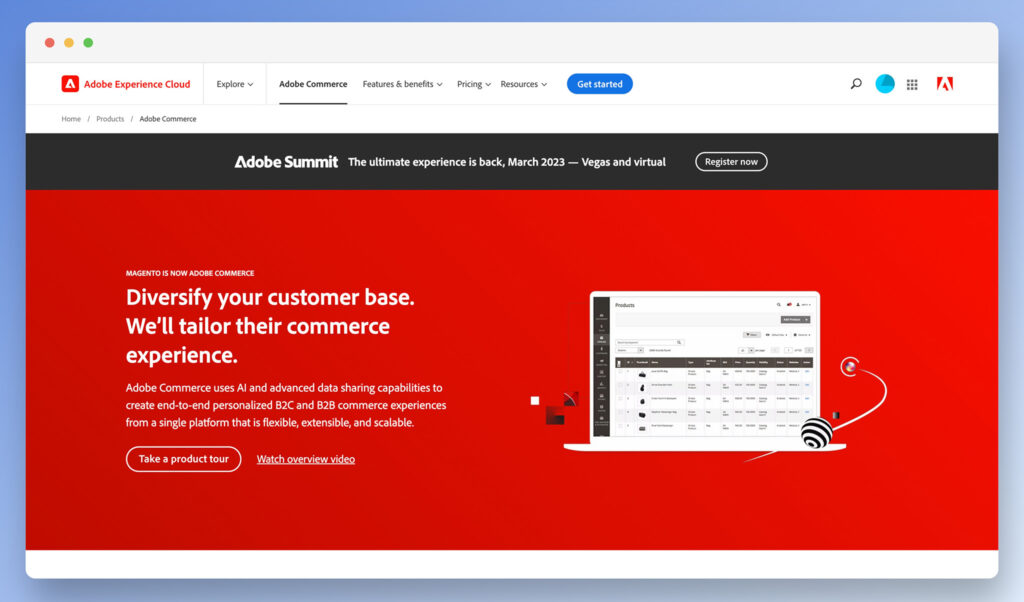
Previously known as “Magento Commerce”, Adobe Commerce is a powerful solution for end-to-end headless functionality. Built on the open-source Magento environment, Adobe Commerce has everything you need to build a truly scalable and extensible store. There’s a convenient page builder with an easy-to-use interface, a visual merchandiser, and complete inventory management built-in.
One of the best things about Adobe Commerce is its specially designed to suit all kinds of business models. You can create a powerful B2C, B2B, or D2C sales environment, with easy integrations with your back-end systems. There are various purchasing options to choose from, in-depth reports to help you understand your sales, and a range of payment service options.
The API-based headless commerce platform is agile, fand flexible. There are more than 500 GraphQL and REST API operations offered by the system, with complete freedom and functionality available across all ecommerce layers. You can even use the PWA studio to build progressive web applications using a range of integrated Adobe tools. Plus, there’s the Adobe Experience Manager for fantastic personalization and customization.
Like most leading headless ecommerce solutions, Adobe Commerce also integrates seamlessly with a range of tools from across the digital landscape. This means you have the power to implement all of the technology you need into one environment.
Pricing
Similarly to most headless ecommerce solutions, there’s no direct pricing available for Adobe Commerce. You’ll need to contact the team to have a custom quote created for your specific needs. However, prices can start at around $22,000 per year, depending on your revenue.
Pros 👍
- Exceptional flexibility for any front-end experience
- Customer experience control system for personalized integrations
- PWA technology to help you build better applications
- Convenient APIs and services available for all touchpoints
- Endless possibilities to integrate with existing tools and services
- Unlimited scale for growing business owners
Cons 👎
- Requires a decent amount of technical knowledge
- Can be quite expensive
5. Swell
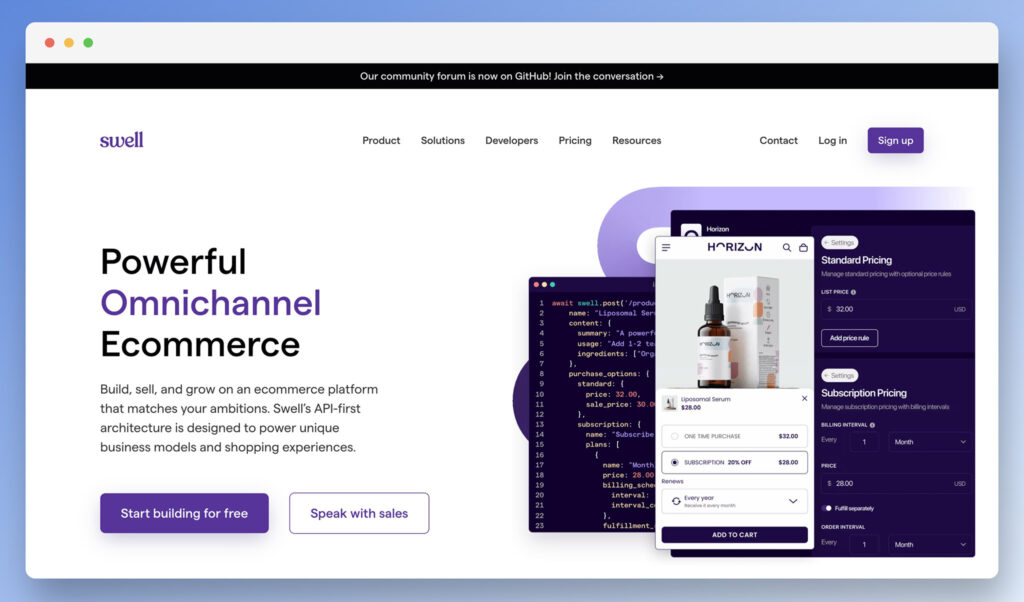
One of the top solution providers focusing on next-level commerce experiences, Swell supports endless omnichannel interactions for B2C and B2B companies. You can build, sell, and grow your business according to your specific needs, with an API-first architecture. Building with Swell gives you all the freedom you need to evolve without extra subscription fees or hefty costs.
The technology works with modern JAMstack tools and frameworks, and comes with a variety of templates to get you started. You can dive in with a range of customizable data models to help keep all of your information in one place. There are storefront themes for beginners, and deep integrations available with all of the tools you might already use.
Swell also has a built-in experience management system, with a seamless hosted checkout environment, which offers granular control. The modern dashboard makes it easy to keep track of everyday sales and subscriptions alike. What’s more, Swell givers you a huge range of analytics and insights to boost your chances of long-term sales.
Swell is particularly ideal for companies offering subscription-based purchases. The fully integrated billing and pricing engine makes it easy to manage everything from a single backend. You can also process payments with multiple gateways using the available APIs.
Pricing
Swell is one of the few headless ecommerce solutions with its own dedicated pricing page. The first option you’ll have is the “Community” package, is which has no subscription price, but you will need to give 2% of your sales to Swell. The “Standard” plan is $299 per month with more direct support and time-saving features for big teams.
Finally, the Enterprise package, with complete headless functionality and greater control starts at around $2,000 per month. The pricing varies according to your annual order volume. The higher your sales, the more you’ll need to pay to connect all your payment gateways, platforms, and ecommerce sites.
Pros 👍
- Intuitive all-in-one dashboard suitable for all users
- Customizable checkout flows with API functionality
- Ready-made headless themes and storefronts
- Faster time-to-market with auto-scaling servers and a global CDN
- Suitable for non-technical users in some use cases
- Affordable for beginners
Cons 👎
- Limited support on some plans
- Only the enterprise plan supports unlimited APIs
Why Use a Headless Ecommerce Platform?
Before we dive into our list of some of the most attractive ecommerce platforms for headless design, let’s take a closer look at why you might choose a headless platform for your store.
Ultimately, headless ecommerce isn’t nearly as straightforward as using a traditional store builder to create your store with drag-and-drop components. It can also cost quite a lot, making it less appealing to smaller companies with limited budgets.
However, headless ecommerce does offer a lot of unique benefits, including:
- Customizability: Because headless ecommerce platforms split the front and back end of your store into two separate layers, it gives you endless freedom to design your store however you choose. You can choose an ecommerce platform with all the functionality you need to sell, while also leveraging your favorite front-end solution, whether it’s a CMS, CRM, or something else entirely. This gives you more opportunities to create a unique experience.
- Scalability: Every ecommerce business owner wants to accelerate their growth and find new customers as quickly as possible. However, the more you grow, the more likely it is that your traditional ecommerce service will become less effective. With a headless solution, you can adjust your front-end without making any changes to the backend, using APIs. This gives you fantastic room for growth, no matter how much your store evolves.
- Personalization: Countless studies have shown personalized commerce is the key to winning the hearts and minds of customers in a fierce ecommerce world. Following the headless approach means business leaders can create more dynamic, seamless, and personalized shopping experiences, leveraging information rom your CRM. You can provide each of your customers with a totally unique experience.
- Omnichannel: Today’s customers spread their purchasing journeys across a multitude of different channels. Unfortunately, it’s often difficult to link all of these environments together using a traditional ecommerce tool. A headless solution can ensure you can deliver the same experience to your customers, regardless of where they interact withy our brand. You can even link offline interactions to the online world with the Internet of Things.
- Innovation: While most traditional ecommerce tools give you some freedom to add new functionality and rich features to your existing ecommerce store, few give you the same versatility as a headless platform. API-focused solutions give you endless integration opportunities, for a truly special shopping experience. You can innovate and evolve as much as you like, provided you have the right developer knowledge.
Simply put, a headless ecommerce platform is a fantastic way to connect all of your CRM systems, ERP systems, traditional commerce sites and other tool in one convenient place. Just remember, while there are tutorials and guides out there to help you get started, you may need to invest in extra developer help to bring your tech stack together.
Choosing the Best Headless Commerce Platform
The best headless commerce platform provides retailers and ecommerce merchants with a powerful and versatile environment for building unique user experience.
These cloud-based tools, SaaS systems, and versatile platforms are great for CX optimization. With headless architecture, you can deliver a seamless customer experience across every IoT device, mobile app, website, and any other touchpoint where you may interact with your target audience, such as modern wearables.
While some headless CMS and ecommerce platforms make it simple to develop your online and offline presence with microservices apps, SDKs, and toolkits, others require a little more technical knowledge. Make sure you have a clear idea of what kind of skills you can use to build your digital commerce strategy before you start looking at an enterprise-level tool.
If you don’t have the developer skills required to future-proof your company with headless ecommerce, it may worth looking for a platform with pre-built plugins or a partner marketplace where you can seek out extra customer support. Many platforms have partner developers to assist with automation, building new commerce functionality, and increasing conversion rates.




Comments 0 Responses